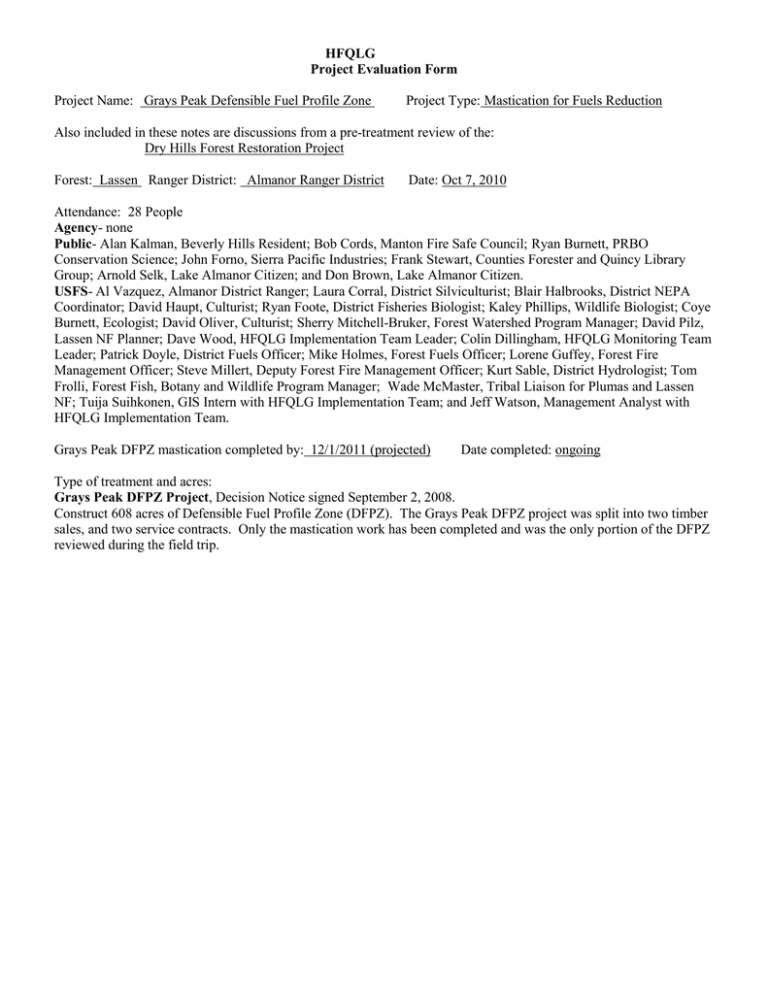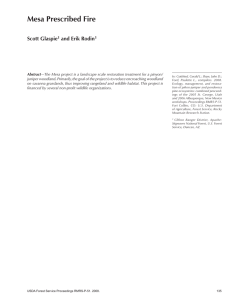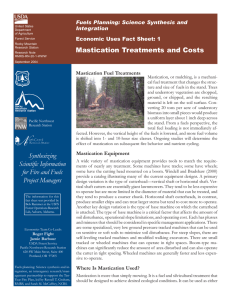HFQLG Project Evaluation Form
advertisement

HFQLG Project Evaluation Form Project Name: Grays Peak Defensible Fuel Profile Zone Project Type: Mastication for Fuels Reduction Also included in these notes are discussions from a pre-treatment review of the: Dry Hills Forest Restoration Project Forest: Lassen Ranger District: Almanor Ranger District Date: Oct 7, 2010 Attendance: 28 People Agency- none Public- Alan Kalman, Beverly Hills Resident; Bob Cords, Manton Fire Safe Council; Ryan Burnett, PRBO Conservation Science; John Forno, Sierra Pacific Industries; Frank Stewart, Counties Forester and Quincy Library Group; Arnold Selk, Lake Almanor Citizen; and Don Brown, Lake Almanor Citizen. USFS- Al Vazquez, Almanor District Ranger; Laura Corral, District Silviculturist; Blair Halbrooks, District NEPA Coordinator; David Haupt, Culturist; Ryan Foote, District Fisheries Biologist; Kaley Phillips, Wildlife Biologist; Coye Burnett, Ecologist; David Oliver, Culturist; Sherry Mitchell-Bruker, Forest Watershed Program Manager; David Pilz, Lassen NF Planner; Dave Wood, HFQLG Implementation Team Leader; Colin Dillingham, HFQLG Monitoring Team Leader; Patrick Doyle, District Fuels Officer; Mike Holmes, Forest Fuels Officer; Lorene Guffey, Forest Fire Management Officer; Steve Millert, Deputy Forest Fire Management Officer; Kurt Sable, District Hydrologist; Tom Frolli, Forest Fish, Botany and Wildlife Program Manager; Wade McMaster, Tribal Liaison for Plumas and Lassen NF; Tuija Suihkonen, GIS Intern with HFQLG Implementation Team; and Jeff Watson, Management Analyst with HFQLG Implementation Team. Grays Peak DFPZ mastication completed by: 12/1/2011 (projected) Date completed: ongoing Type of treatment and acres: Grays Peak DFPZ Project, Decision Notice signed September 2, 2008. Construct 608 acres of Defensible Fuel Profile Zone (DFPZ). The Grays Peak DFPZ project was split into two timber sales, and two service contracts. Only the mastication work has been completed and was the only portion of the DFPZ reviewed during the field trip. Grays Peak DFPZ project monitoring review Resource Attribute Objective Area Reduce competition Improve of retained trees, thin Silviculture Forest Health trees to 16 X 16 foot spacing Remove ladder fuels to prevent crown fire Fuels Ladder Fuels initiation and sustained crown fire. Source of Objective Degree Met EA and Silviculture prescription Yes The thinning project reduced competition and should increase vigor of remaining trees HFQLG FEIS, Appendix J Yes Mastication prescription removed ladder fuels, but added to surface fuels. Rearrange fuels to attain less than 4 foot flame length HFQLG FEIS, Appendix J Yes USFS Memorandum of Understanding with USWS No Fuels Surface Fuels Wildlife Shrub dependant wildlife species Prevent direct loss of nesting birds Wildlife Shrub dependant wildlife species Maintain high productivity in shrub habitats Comments EA Yes Mastication treatment of brush and trees slows rate of fire spread and reduces flame length. Mastication treatment occurred during songbird nesting season, causing direct loss of nestlings and eggs. Mastication treatment expected to regenerate old, less productive shrub field. Grays Peak DFPZ Project – unit 115 of Grays Peak DFPZ with mastication treatment. Though not visible in this picture, there was approximately one acre of brush left within the mastication unit to contribute to wildlife habitat needs. Grays Peak DFPZ Project – David Oliver, district culturist, explains purpose of mastication treatment. Within this larger mastication unit (unit 102), patches totaling approximately five acres of brush were left to contribute to wildlife habitat needs. Grays Peak DFPZ Project – At the second stop of the mastication treatment, the surface fuels were deeper due to heavier brush and tree component that were masticated to create the DFPZ. Dry Hills Forest Restoration Project (Proposed) Dry Hills Forest Restoration Project – Patrick Doyle (far left) explains the expected effectiveness of a completed DFPZ in the project area. Dry Hills Forest Restoration Project – Patrick Doyle (far left) Laura Corral and Kaley Phillips discuss the objectives of the proposed Dry Hills Forest Restoration Project and some of the actions intended to meet the needs of the project area. Dry Hills Forest Restoration Project – The Defensible Fuel Profile Zone has incorporated new ideas such as retaining clumps of trees for wildlife and increasing variable spacing of reserved trees. These proposed treatments are intended to meet fuels and firefighter safety objectives for DFPZs while implementing actions that also address forest health and wildlife needs. Dry Hills Forest Restoration Project – Ryan Foote (yellow hardhat) discusses proposed riparian treatments to improve resiliency of riparian areas within the Defensible Fuel Profile Zone network. Dry Hills Forest Restoration Project – Kurt Sable (yellow hardhat) discusses existing condition of Dry Lake and how historic channels cut into the area drain it earlier in the season than it should naturally drain. No specific proposal has been developed, but the district is trying to determine the best method to retain water in the system later into the summer season. Follow up actions: Implement Grays Peak project and monitor results. Finish planning Dry Hills Forest Restoration project. Notes prepared by HFQLG Monitoring Team Leader: /s/ Reviewed by District Ranger: Colin Dillingham __/s/ Alfred G. Vazquez Date: 10/7/2010 Date: 10/29/2010


